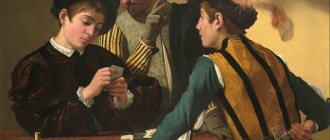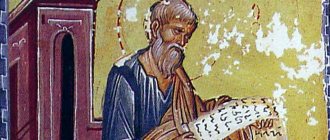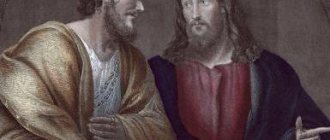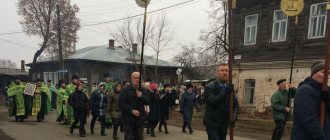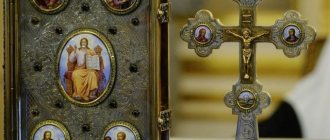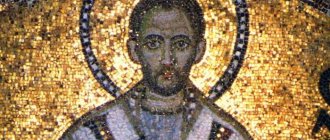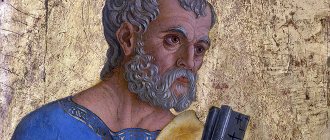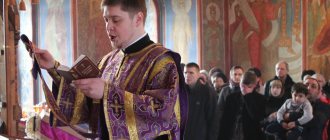Портреты Караваджо
| R”авид СЃ головой Голиафа (фрагмент Резображает S…удожниРєР°) | RџРѕСЂС‚рет Караваджо |
RљР°СЂР°РІР°РґР¶Рѕ RњРёРєРµР»Р°РЅРґР¶РµР»Рѕ
(Michelangelo Merisi da Caravaggio) (1573-1610), итальянский Р¶Ревописец.
Основоположник реалистического направления РІ евр опейской жовопоЃРё VII века, внес РІ нее RїРѕРІС‹С€РµРЅРЅРѕРµ S‡СѓРІСЃS ‚РІРѕ эмоциона R»СЊРЅРѕРіРѕ напряжения, выраженное S‡РµСЂРµР· RєРѕРЅС‚расты СЃР ІРµС‚Р° Рё тени (караваджизм).
Учился в Милане; работал в Риме, Неаполе, на островах Мальта и Сицилия.
Караваджо, РЅРµ принадлежавший Рє определенной С…СѓРґРѕР¶РµСЃС ‚венной рколе, уже РІ ранних произведенияS… противопоставил ЂР°Р·РёС‚ельность RјРѕРґРµР»Рё, простые бытовые РјРѕС‚ РёРІС‹ («Маленький больной Р'акх», «Юноша СЃ РєРѕСЂР·РёРЅРѕР№ фруктоРIV") идеаР" изацРеРё образов оаллегорическому РѕЃС‚олкованию SЃСЋР¶РµС ‚Р°, свойственным искусству РјР° ньеризма Рё академизма. Художник внес большой вклад РІ становленве бытового жаРСЂР° («ЫадалкР°B"). Зрелые произведения Караваджо — это RјРѕРЅСѓРјРµРЅС‚Р°Р»СЊРЅС ‹Рµ полотна, обладающ РёРµ исключительной драматической силой («Призвание ап остола Матфея» Рё «Мученичество апостола Матфея», «Положение РІРѕ РіСЂР ѕР±В", В"Смерть МарииВ"). вввописная манера Караваджо РІ этот период основана R ЅР° мощных контрастах света Рё тени, выразительной простоте R¶РµСЃС‚РѕРІ, СОнергично Р№ лепке объемов, насыщенности РєРѕР» орита — приемаС..., создающих эмоциональное напряжениРµ, острую аффектацию С‡ SѓРІСЃС‚РІ. Подчеркнутая «простонародность» типажей, СѓС‚РІРµС ЂР¶РґРµРЅРёРµ идеалов демократизма поставил Рё Караваджо РІ оппозицию РїРѕ отношенок Рє современномS ѓ обрекли его РІ последние РіРѕРґС‹ жизни РЅР° СЃРєРёС ‚R °РЅРёСЏ РїРѕ СЋРіСѓ Рталии. Р' РїРѕР·РґРЅРёС… произведенияS… Караваджо RѕР±СЂР°С‰Р°РµС‚СЃСЏ Рє теме RѕРґРёРЅРѕС‡РµСЃС‚РІР° S‡РµР»РѕРІРµРєР° RІРѕ враждебном ему РјРјСЂРµ, его пргвлекает образ небольшого SЃРѕР ґСЂСѓР¶РµСЃС‚РІР° людей, объединенных родственной Р± R»РёР·РѕСЃС‚СЊСЋ иушевным S‚еплом («Погребение RЎРІСЏС‚РѕР№ ЛюS ‡РеРёВ"). Свет РІ его картинах становвится RјСЏРіРєРёРј Рё RїРѕРґРІРёР¶РЅС‹Рј, R єРѕР»РѕСЂРёС‚ тяготеет Рє тональному RµРґРёРЅСству, РјР °РЅРµСЂР° РїРёСЃСЊРјР° РїСЂРеобретает S…арактер SЃРІРѕР±РѕРґРЅРѕР№ РёРјРїСЂРѕРІ РезацРеонности.
RўРІРѕСЂС‡РµСЃРєР°СЏ RјР°РЅРµСЂР° RљР°СЂР°РІР°РґР¶Рѕ RѕРєР°Р·Р°Р»Р° RхепосредствеРSРЅРѕРµ влияРСРеРµ РЅР° сложение караваджиР·РјР° — SЃР°РјРѕСЃС‚оятельного направления РІ европейском Рё SЃРєСѓСЃСЃС‚РІРµ XVII века.
КартРеРЅС‹ Караваджо РЅР° RјРёС„оЂогические Рљ античные СЃСЋР ¶РµС‚С‹:
| RќР°СЂС†РёСЃСЃ | R“оДова Медузы, 1600 | RњР°Р»РµРЅСЊРєРёР№ больной R'акх |
| R'R°RєS… | R'акх, фрагмент | R'акх, фрагмент | R'акх, фрагмент |
| RЎРїСЏС‰РеР№ РљСѓРїРёРґРѕРЅ | R®РїРёС‚ер, RќРµРїС‚СѓРЅ Плутон | РђРјСѓСЂ-победитель |
КартРеРЅС‹ Караваджо РЅР° Р±Реблейские сюжеты:
| Давид, 1600 | Давид, 1606 | Давид, 1609 |
| Жертвоприношение Рсаака, 1605 | Жертвоприношение Рсаака |
| Юдифь и Олоферн | R'оскрешение Лазаря, 1609 |
| Р'лаговещение | Отдых РЅР° пути РІ Египет | Поклонение пастухов |
| Рождество СЃРѕ Святыми R¤СЂР°РЅС†РёСЃРєРѕРј Ryo R›РѕСѓСЂРµРЅСЃРѕРј | Мадонна дей Палафреньери, 1606, Р'оргезе | Мадонна дель Россарио |
| Успение Святой Девы | Мадонна Пелегрини | Седьмое деяние Мерси |
| РЎРµ человек, 1606 | RЈРІРµРЅС‡Р°РЅРёРµ S‚ерновым RІРµРЅС†РѕРј, 1603 | R'ичевание Христа, 1607 |
| R'ичевание Христа, 1607 | Разговор Христа |
| Христос РІ Рмманусе | Христос РІ Рмманусе, 1606 |
| RЈРІРµСЂРµРЅРёРµ Фомы | Отречение Святого Петра |
| RЎРІСЏС‚РѕР№ Рероним | RЎРІСЏС‚РѕР№ Рероним |
| Ркстаз Святого Франциска | Саломея СЃ головой Соанна Крестителя |
| Усекновение главы Роанна Крестителя, 1608 | Rоанн Креститель |
| Юный Коанн Креститель, Капитолийский музей | Rоанн Креститель | Юный Роанн Креститель Сѓ СЂРѕРґРЅРёРєР°, 1608 |
| Rоанн Креститель | Rоанн Креститель | Распятие Святого Петра, 1600 |
| P | Положеное РІРѕ РіСЂРѕР±, 1603, Пинакотека, Р'атикан | RЎРІСЏС‚ая ЕкатерРеРЅР° Александрийская |
| RЎРІСЏС‚РѕР№ Франциск, 1606 | ОбращенРеРµ Святого Матфея | RЎРІСЏС‚РѕР№ Франциск, 1606 |
| ОбращенРеРµ Павла, 1600 | ОбращенРеРµ Павла, 1600 | Мария Магдалена |
| RЎРІСЏС‹Рµ Марфа Ро Мария Магдалена | Мученичество Святой Урсулы |
| Погребение Святой Люции | Мученичество апостола Матфея |
RЎРІСЏС‚РѕР№ Матфей Рё ангел
R”SЂSѓRiRyoRµ RєR°SЂS‚РёРЅС‹ RљР°СЂР°РІР°РґР¶Рѕ:
| Гадалка | Гадалка |
| Шулеры | RљРѕРЅС†РµСЂС‚, 1595 |
| R›СЋС‚РЅРёСЃС‚ | R›СЋС‚РЅРёСЃС‚ |
| R›СЋС‚РЅРёСЃС‚, фрагмент | R›СЋС‚РЅРёСЃС‚, фрагмент |
| R›СЋС‚РЅРёСЃС‚, фрагмент | RќР°С‚СЋСЂРјРѕСЂС‚ СЃ цветами Ryo S„руктами |
| Юноша СЃ РєРѕСЂР·РеРЅРѕР№ фруктов, 1593 | МальчРеРє, укушенный ящерицей, 1593 | Юноша, чистящий фрукты, 1593 |
| Алоф РґРµ Р'Режнакурт, 1608 | Удаление Р·СѓР±РѕРІ, 1607 | Маффео Р'арберРеРЅРё, 1599 |
Source: https://sschool8.narod.ru/Masters/A_Caravaggio.htm
The Riddle of Caravaggio: “The Calling of the Apostle Matthew”
Passing from there, Jesus saw a man named Matthew sitting at the toll booth, and he said to him, “Follow Me.” And he stood up and followed Him. Matthew 9:9
Good afternoon Today I would like to talk to you about Caravaggio’s painting “The Calling of Matthew the Apostle,” which he painted for the Contarelli Chapel in the Roman Church of San Luigi dei Francesi in 1599.
What do we see in the picture? An ordinary tavern from the time of Caravaggio, people in ordinary clothes, the painstaking and important moment of counting money is underway, two guards ensure calm in the tavern. They are dressed in the latest fashion, one of them - the one sitting with his back to us - we see a sword.
At this moment, the doors of the tavern swing open, and Someone else bursts into the usual bustle of counting money. Different, truly different from a local company. This Other, Jesus, brings with him a ray of light that literally cuts the canvas of the painting.
And although Christ’s gesture is one of the most powerful in this picture, we do not see the whole of Jesus - the figure of Peter obscures him for us.
Peter seems to repeat the movements of Jesus, perhaps a little clumsily, but it is Peter who becomes for us the one behind whom we can observe the gesture of Christ.
This is surprising because it fully reflects the idea of the Church as the visible expression of the present Christ, finding its ultimate expression in the figure of Peter and his ministry. Jesus calls us, calls us, but not through abstract expressions, but through the community of His disciples, through the Church.
Let's turn to a company that is busy counting money. Of course, the question arises who is Matthew in this picture. We have already seen Christ, who with an expressive gesture invites us to follow him, we have seen Peter, through whom the gesture of Christ is revealed to the viewers of the picture, but who is Matthew?
There are several opinions on this question. According to the classical interpretation, Matthew is an old man with a beard who points to himself with a questioning gesture. The question freezes on his lips - Who am I?
It’s as if the person can’t believe what’s happening. His eyes are full of amazement, he himself is surprised at the choice of Jesus. Should I, sinful Matthew, become Your disciple? How often we do not “trust” the choice of Jesus. We, weak and sinful, inconsistent, we who often make mistakes, must become His disciples.
- This is a “classical” interpretation of the picture, but, as I wrote above, not everything is so simple.
- According to some experts, art historians and ordinary people, Matthew in the painting is a young man who is counting money.
As we know from the Gospel, Matthew was a tax collector, that is, he is a person who collects money. Indeed, in Caravaggio’s painting it is he who is counting and raking in the money for himself. With his right hand he counts the coins, which are given to him by an adult man with a beard.
History of creation[ | ]
According to the will of the wealthy construction contractor Mathieu Contrelle (Matteo Cantarelli), the chapel in honor of the Evangelist Matthew in the church of the French community of San Luigi dei Francesi was to be decorated with fresco paintings. The subject of the paintings and their quantity were strictly specified by the testator. In 1593, a contract for these works was signed with the famous Roman artist Cesari d'Arpino, Caravaggio's former master and rival. However, the very popular d'Arpino, overwhelmed with orders, by 1599 completed only the painting of the chapel vault. Due to fears that the church would not be completed by the anniversary year, and given the dissatisfaction of the French ambassador Philippe de Bethune, the manager of the Contarelli Foundation, Virgilio Crescenzi, broke the agreement with d'Arpino and turned to Caravaggio. This was the artist’s first work intended not for private customers, but for the general public. Caravaggio abandoned fresco painting and completed the order on large canvases. The first painting, “The Calling of the Apostle Matthew,” was delivered to the church from the Navicella Palace, where the artist’s workshop was then located, on the eve of Christmas. Caravaggio’s work is considered one of the most significant paintings on the gospel story of the calling of Matthew, rarely seen in fine art.
Caravaggio "The Calling of the Apostle Matthew"
In the Roman church of San Luigi dei Francesi hangs the painting “The Calling of the Apostle Matthew,” painted at the very beginning of the 17th century. You, of course, know this gospel parable? “...Jesus saw a man named Matthew sitting at the toll booth and said to him: Follow me. And he stood up and followed him.” The calling to the apostolic service of a publican (tax collector), the future author of one of the canonical Gospels, is one of the most symbolic episodes of the New Testament, so it is not surprising that at all times this plot was popular among Christian artists.
The incident with the publican was most vividly, most expressively embodied in this wonderful painting hanging in the Contarelli Chapel of the Church of San Luigi dei Francesi. Even now, in the 21st century, the picture makes a very strong impression on the viewer, but 400 years ago it was an explosion, a scandal, a challenge to all norms and traditions.
A gloomy, semi-dark room... A company settled down at a low table - a gloomy-looking old man and four young dandies.
What kind of room is this - a tavern? A hangout? What are these people doing? Are the publican Matthew and his assistants counting the collected taxes, or are they playing dice with the young rakes? The words of the Gospel “at the collection of duties” seem to be clear and definite, but Matthew’s “helpers” are too young, it is difficult to imagine them in the role of tax collectors.
This question is not as important as it might seem at first glance. The profession of a publican has never enjoyed honor and respect among any people, so it is not difficult to imagine such a person in a gloomy closet, playing cards or dice for money.
But then the darkness recedes, a wide ray of light falls on those sitting at the table! Everyone turns to the open door, except for one of the young men, whom nothing can distract from the pile of coins under his hands.
In the radiance of daylight, Christ and the Apostle Peter enter the room, and Christ points with a majestic gesture to Matthew, letting him know that his time in closets and nooks is over, that great service awaits him. Yes, we know that Matthew will now push away the stool, and, to the joy of the youths, forgetting about his money, will follow Christ and Peter to where this powerful stream of sunlight comes from, but this will only happen in a moment, and for now the stunned Matthew looks on at those who entered and points a finger at himself, wondering: “Me”?
The paintings of this artist broke so sharply with tradition that customers, Italian churches, indignantly refused his work. Church hierarchs considered it unacceptable to portray Christ’s companions as so “earthly,” so “rude.” The altar “St. Matthew and the Angel,” for example, the artist had to paint twice.
The first version, which does not comply with Catholic canons, ended up in a private collection (as did the rest of the works rejected by the church), and the second, executed in a traditional manner, was favorably received by the customer.
Who was this man who so easily rejected the canons that had developed over centuries? If you are passionate about art, but don’t always have the money for it, then you can take out a loan on the website https://krednal.ru/credit-nalichnimi/.
Michelangelo Merisi was born in 1573 in the small town of Caravaggio, not far from Milan, from where his name, Caravaggio, became famous for centuries. Not much is known about his childhood. There is reason to believe that the family was quite wealthy, although not rich. Caravaggio's teacher was the once famous painter Simone Paterzano.
Composition of the painting[ | ]
This painting was executed by Caravaggio for the Contarelli Chapel of the Roman Church of San Luigi dei Francesi in 1599. It was a French temple located in Rome. The painting is located on the left wall of the chapel and those approaching it see the entire composition from a strong perspective, which coincides with the commanding gesture of Jesus’ hand and is further emphasized by a ray of light diagonally crossing the painting and cutting like a knife into the dim space of the Italian tavern , in which an action is performed at the will of the artist. The size of the painting is significant: The most remarkable thing about it is that, despite the obvious theatricality of the scene and even the far-fetched nature of the composition, “the Italian master reveals a tendency to transform the space of representation into a field of experience. The stream of light falling from the side where Jesus and the Apostle Peter are standing directs the viewer’s gaze, forcing him to read the scene against the flow of light: from left to right. This creates a special tension. The figure of Jesus is almost completely covered by Peter - only the head with a thin halo and hand are clearly highlighted against a dark background.
Despite the demonstrative naturalism of the scene and the maximum proximity of the figures to the viewer (a constant technique in the artist’s work), much in this picture remains mysterious. According to the canonical interpretation, the physical ray of light symbolizes the light of faith that burst into the vain, vain world of Matthew Levi. Unlike the works of the Mannerists of that time, Caravaggio’s visual language is clear to an untrained viewer, and this is what created the enormous popularity of his paintings.
Caravaggio “The Calling of Matthew.” The most unusual painting by the master
Caravaggio. The Calling of Saint Matthew. 1599-1600 Church of San Luigi dei Francesi, Rome.
“The Calling of Saint Matthew” is one of Caravaggio’s most unusual paintings. She created a sensation among the master's contemporaries.
Even now she seems extraordinary. Christ is not in the center. And not in the most visible place.
No, on the contrary. In the very corner of the picture. In the shadow. And even almost completely hidden by another figure! But we still see it right away. Thanks to his beautiful and noble gesture “You! Follow me!"
And who among those sitting is Matthew? Seems obvious. The one who points at himself “Who? I? Should I follow you? No. It's not him.
Although most art historians believe that this is Matthew. I still adhere to a different version. It is shared by a much smaller number of specialists. But still she is closer to me.
Who is Matthew in the picture?
According to this less popular version, this is how I read the painting.
The taxpayer is sitting facing us. With beard. In a black beret with an expensive brooch. He is 35-38 years old. With one hand he places the coins in the middle of the table.
Next to him is a young man of 14-15 years old. Well dressed too. His son or student. And the old man. Apparently the accountant was taken with him.
The nobles themselves were unlikely to engage in such matters. Most likely, it was the manager and his assistants who came to pay taxes. For crossing the bridge. For using paved roads. You never know for what else.
Matthew is the city publican. In modern language - tax collector. With one hand he counts the coins. The other one holds the wallet tightly. He sits at the head of the table. On the chair. He's the boss here. The client can also sit on the bench.
Caravaggio. The Calling of Saint Matthew. Fragment. 1599-1600 Church of San Luigi dei Francesi, Rome. wga.hu
He's young. He is not yet thirty. But this is not surprising. After all, the profession was inherited from his father.
He took his bodyguard to the meeting with the taxpayer. This is a young man. Dexterously wielding a sword. Arriving at the tavern, he turned the bench across. And he brazenly sat down on her opposite the well-groomed young man. He is impudent and pugnacious. His hooked nose and small eyes match his sword. His image slightly frightens intractable debtors.
Suddenly Christ enters the tavern with the Apostle Peter. A ray of light “cuts” space. It was as if a ray of salvation had broken through into the dark world of sins and vices.
Caravaggio. The Calling of Saint Matthew. Fragment. 1599-1600 Church of San Luigi dei Francesi, Rome. wga.hu
The publican's bodyguard instinctively leaned forward. His hand reaches for the sword. Not surprising. In such a hot place you can meet anyone. Including thugs hungry for easy prey.
The young man, on the contrary, pulled back, leaning on his father or teacher. He's not used to everyday fights. Unlike its neighbor opposite.
Caravaggio. The Calling of Saint Matthew. Fragment. 1599-1600 Church of San Luigi dei Francesi, Rome. wga.hu
Matthew had not yet had time to raise his eyes. He is immersed in counting money. He still belongs to this world of sin and vice. But Christ is already calling him. We know that in a second he will look up. And he will follow the teacher.
Caravaggio. The Calling of Saint Matthew. Fragment. 1599-1600 Church of San Luigi dei Francesi, Rome. wga.hu
Another fact speaks in favor of the fact that it is the young man at the head of the table who is Saint Matthew.
For the same church, Caravaggio painted another painting, “St. Matthew and the Angel.”
Caravaggio. Saint Matthew and the Angel. 1600 (Copy). Original lost during World War II
Judging by this picture, Caravaggio depicted that same young man in old age. Same pose and look. The same big head and stocky figure. Look how different the man with the beard is from the old Matthew.
By the way, the painting “Saint Matthew and the Angel” is long-suffering. The customers did not accept it. The church servants were outraged by the sight of the saint. How is it possible? Some tramp with dirty heels. And he was hunched over a book! Where is the sublimity of the image? Where is the holiness?
This was not the only rejected work of the master. I wrote about this in detail in the article “Caravaggio. 5 incredible facts of life and creativity.”
To please the church, Caravaggio painted another “Saint Matthew”. She no longer resembles the young man. Apparently there was no time for that.
Caravaggio. Saint Matthew and the Angel. 1600 Church of San Luigi dei Francesi, Rome. Wikimedia.m.commons.org
Why did Caravaggio “hide” Christ?
Yes, the picture is unusual. Caravaggio was able to masterfully show the collision of the ordinary and the sinful. With a miracle and the light of hope for salvation.
Painting "The Calling of the Apostle Matthew"
Date of creation: 1599. Dimensions: 322*340 cm. Type: oil on canvas.
Location: Church of San Luigi in Rome.
Caravaggio
One of the best painters of all time, Caravaggio is known for his realistic Baroque work. Despite his reckless nature, he was an influential 17th-century Italian artist who created large-scale works with religious themes in Rome and Naples.
At the end of the 16th century, Caravaggio moved to Rome, where he quickly found patrons, one of whom was Francesco del Monte, who helped the master get his first major project - decorating the side walls of the chapel in San Luigi.
This work included The Call of St. Matthew the Apostle , as well as the Inspiration (1602) and the Martyrdom of St. Matthew (1599–1600).
These works were a success, and subsequent works contributed to the establishment of the master's reputation, making him one of the best creators of religious paintings in Rome, as well as spawning a number of imitators and followers. Despite the unique style and realism in the works, some conservative clergy considered a number of paintings vulgar, despite their demand.
The ceiling of the chapel was painted by Giuseppe Cesari, however, due to his busy schedule, he was unable to complete the work on the entire church. Then Cardinal Del Monte intervened, providing work for Caravaggio.
Martyrdom of Matthew
The Calling of the Apostle Matthew
“The Calling of Matthew” depicts the moment in which Jesus Christ inspires Matthew to follow the Lord and go on to become an apostle. This scene illustrates a passage from the Gospel of Matthew. After the call to “follow me,” Matthew complies with the request.
Christ (to the right of Peter) points to Levi, the tax collector (a bearded man in a beret) who appears repeatedly in works for this church. Confused and uncertain Matthew, seeing Christ pointing at him, responds with a gesture, as if asking: “Me?”
The rays of light illuminating the two young men create a visual contrast between the reactions of these characters, showing extreme forms of possible behavior in the same situation.
The drama of the scene lies in the captured moment when the characters present are in shock, and Matthew himself is indecisive and in complete confusion, despite Christ experiencing monumental confidence. The author borrows the simple aesthetics of the work from his early genre painting, so the picture has much in common with fortune tellers and sharpers, in which events also take place in a tavern.
Sharpies
As in other paintings dedicated to Christianity, Caravaggio conveys the sacredness of the scene through informal imagery. An elderly man with lenses in his hands and his colleague, busily counting the proceeds, contrast with the beggar and barefoot Jesus.
Christ shows the cleansing light of faith that can invade the dark abode of greed and other sins. The Church saw the son of God as the second Adam, probably hence his gesture, identical to the gesture of the first man in the fresco of the Creation of Adam, by the great Michelangelo.
In addition, Caravaggio, as in the Supper at Emmaus, shows that significant events and miracles occur in the midst of the most ordinary situations.
Dinner at Emmaus
Later, in 1602, the painting "The Inspiration of St. Matthew" was created for San Luigi, which completed a number of works on this topic.
Painting “The Calling of the Apostle Matthew” updated: October 23, 2017 by Gleb
Religion
Source: https://artrue.ru/style/barocco/caravaggio/kartina-prizvanie-apostola-matfeya.html
